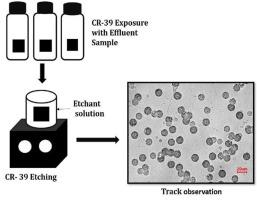Journal of Environmental Radioactivity ( IF 1.9 ) Pub Date : 2021-03-30 , DOI: 10.1016/j.jenvrad.2021.106574 Sushma S. Chavan , Hemlata K. Bagla

|
Natural radioactivity is released into the environment during the combustion process of coal at various thermal power plants. Coal contains higher contents of α-emitting radionuclides such as 238U, 232Th along with their decay elements, which pose a potential health risk to the population. In the present studies, the effluent waste samples were collected from a coal fired Thermal Power Plant. Samples were collected in the form of solid residues and filtrates. CR-39 detector pieces were then exposed for varying time with residue and filtrate samples for registering the alpha tracks for α-detection and measurement. Thus, registered alpha particles in CR-39 detectors were revealed by employing the conventionally used 6M NaOH/KOH etchant and 5% tetraethyl ammonium bromide (TEAB) as a phase transfer catalyst in 6M NaOH/KOH etchant. Under both compositions of the etchants, CR-39 detectors were etched at 60 °C for 6 h for developing alpha tracks for observations under optical transmission microscope. Alpha track densities (Td) and alpha track diameters in the etched CR-39 detectors for all samples were measured. The introduction of new chemical etchant effectively improved the uniformity in distribution of alpha tracks, enhanced the track density, and reduced the time of track revelation in CR-39 detectors. Therefore, it could be concluded that the phase transfer catalyst TEAB was highly effective in the etchant for alpha track revelation and detection as compared to conventionally used 6M NaOH etching method. Apart from measuring alpha radio activities, the amounts of 238U & 232Th in the samples were also measured by ICP-MS for understanding the alpha radio activities measured in the coal samples.
中文翻译:

使用基于CR-39检测器的改进的α径迹检测方法测量火电厂废水中的α放射性
在各种火力发电厂的煤燃烧过程中,自然放射性释放到环境中。煤含有较高含量的发射α的放射性核素,例如238 U,232with及其衰变元素会给人们带来潜在的健康风险。在本研究中,废水废物样本是从燃煤热电厂收集的。样品以固体残留物和滤液的形式收集。然后将CR-39检测器碎片与残留物和滤液样品暴露在不同的时间,以记录用于α检测和测量的α径迹。因此,通过使用常规使用的6M NaOH / KOH蚀刻剂和5%四乙基溴化铵(TEAB)作为6M NaOH / KOH蚀刻剂中的相转移催化剂,可以揭示CR-39检测器中的配准α粒子。在蚀刻剂的两种成分下,将CR-39检测器在60°C的温度下蚀刻6小时,以显影出α迹线,以便在光学透射显微镜下进行观察。阿尔法磁道密度(T d),并测量所有样品在蚀刻后的CR-39检测器中的alpha径径。新型化学蚀刻剂的引入有效地提高了α-磁道分布的均匀性,提高了磁道密度,并减少了CR-39检测器中磁道暴露的时间。因此,可以得出结论,与常规使用的6M NaOH蚀刻方法相比,相转移催化剂TEAB在蚀刻剂中对于α迹线的揭示和检测是非常有效的。除了测量α放射性,还通过ICP-MS测量了样品中238 U和232 Th的含量,以了解煤样品中测量的α放射性。











































 京公网安备 11010802027423号
京公网安备 11010802027423号